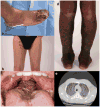HIV-associated Kaposi sarcoma and related diseases
- PMID: 28609402
- PMCID: PMC6310482
- DOI: 10.1097/QAD.0000000000001567
HIV-associated Kaposi sarcoma and related diseases
Abstract
: The search for the etiologic agent for Kaposi sarcoma led to the discovery of Kaposi sarcoma-associated herpesvirus (KSHV) in 1994. KSHV, also called human herpesvirus-8, has since been shown to be the etiologic agent for several other tumors and diseases, including primary effusion lymphoma (PEL), an extracavitary variant of PEL, KSHV-associated diffuse large B-cell lymphoma, a form of multicentric Castleman disease, and KSHV inflammatory cytokine syndrome. KSHV encodes several genes that interfere with innate and specific immunity, thwart apoptosis, enhance cell proliferation and cytokine production, and promote angiogenesis, and these play important roles in disease pathogenesis. HIV is an important cofactor in Kaposi sarcoma pathogenesis, and widespread use of antiretroviral therapy has reduced Kaposi sarcoma incidence. However, Kaposi sarcoma remains the second most frequent tumor arising in HIV-infected patients in the United States and is particularly common in sub-Saharan Africa. KSHV prevalence varies substantially in different populations. KSHV is secreted in saliva, and public health measures to reduce its spread may help reduce the incidence of KSHV-associated diseases. Although there have been advances in the treatment of Kaposi sarcoma, KSHV-multicentric Castleman disease, and PEL, improved therapies are needed, especially those that are appropriate for Kaposi sarcoma in resource-poor regions.
Conflict of interest statement
Research of the authors is supported in part by a CRADA between the National Cancer Institute and Celgene Corp. Also, TSU and RY are co-inventors on a patent application related to the treatment of KSHV-associated diseases with pomalidomide, and the spouse of RY is a co-inventor on a patent related to the measurement of KSHV vIL-6. These inventions were all made as part of their duties as employees of the US Government, and the patents are or will be assigned to U.S. Department of Health and Human Services. The government may convey a portion of the royalties it receives from licensure of its patents to its employee inventors. Finally, RY and TSU have recently conducted clinical research using drugs supplied to the NCI by Merck and Co., Hoffman LaRoche, and Bayer Healthcare.
Figures


References
-
- Centers for Disease C. Kaposi’s sarcoma and Pneumocystis pneumonia among homosexual men--New York City and California. MMWR Morbidity and mortality weekly report. 1981;30(25):305–308. - PubMed
-
- Kaposi M. Idiopathisches multiples Pigmentsarkom der Haut. Archiv Für Dermatologie Und Syphillis. 1872;4:265–273.
-
- Franceschi S, Geddes M. Epidemiology of classic Kaposi’s sarcoma, with special reference to Mediterranean population. Tumori. 1995;81(5):308–314. - PubMed
-
- Gao S-J, Kingsley L, Zheng ML, Zheng W, Parravicini C, Zeigler J, et al. KSHV antibodies among Americans, Italians, and Ugandans with and without Kaposi’s sarcoma. Nature Med. 1996;2(8):925–928. - PubMed
-
- Hymes KB, Cheung T, Greene JB, Prose NS, Marcus A, Ballard H, et al. Kaposi’s sarcoma in homosexual men-a report of eight cases. Lancet. 1981;2(8247):598–600. - PubMed
Publication types
MeSH terms
Grants and funding
LinkOut - more resources
Full Text Sources
Other Literature Sources
Medical

